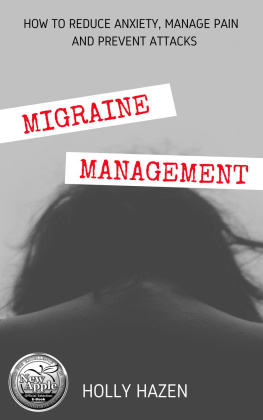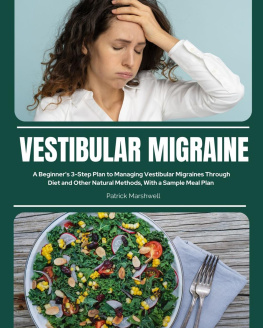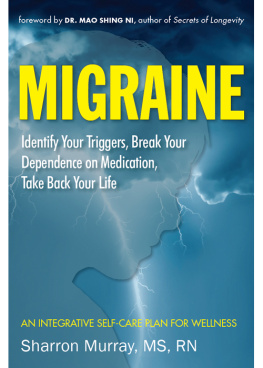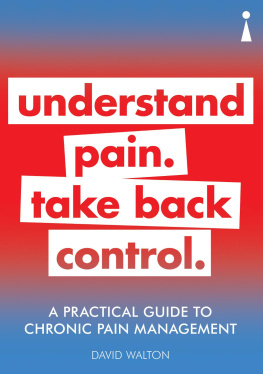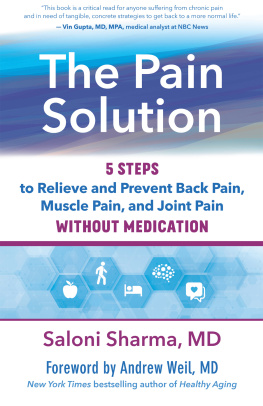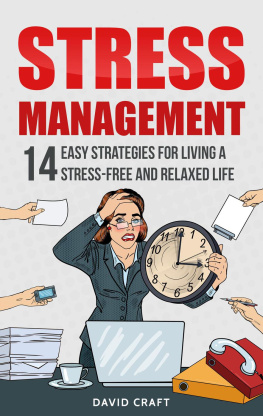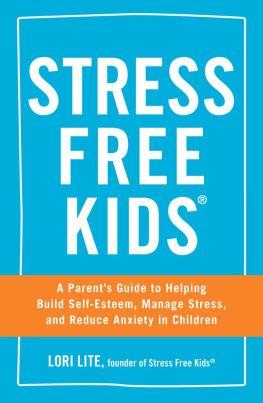Table of Contents
Whats in this Book
Introduction: Tools For Transition
Part One: Tools to Reduce Stress
1.1 What Stress Is: The Physical Reactions Defined
1.2 How We React to Stress
1.3 Using Your Breath to Reduce Stress and Anxiety
1.4 Fifteen Things to Help You Stress Less
1.5 Using Simple Body Awareness
1.6 Quick Stress Relief Using Your Senses
Part Two: Dealing with Majorly Stressful Events in Life
2.1 Phases of Transition You Will Pass Through
2.2 Preparing for the U Curve
2.3 Packing Your Emotional Backpack
2.4 Five Things to Do Two Weeks After You Move
2.5 Everyday Tools to Use ... Every Day!
Part Three: Reverse Therapy For Migraineurs
3.1 How to Make Major Decisions: A Step-by-Step Process
3.2 Allowing Space for the Unknown
3.3 Trusting Your Decision
3.4 Other Ways of Working with Doubt
Part Four: Developing Your Pain Management Strategy
4.1 Recognize Your Early Warning Signals So You Can Stop an Attack
4.2 Discover What Stress Looks Like in Your Body
4.3 Use Medications or Find Alternative Relief
4.4 Be Proactive with the Right Lifestyle Choices
4.5 Packing Your Migraine Prevention Kit
Part Five: Forming New Habits
5.1 Three Steps to Making a Habit Stick
5.2 The Learning Curve
5.3 Dealing with Setbacks
Conclusion: Extra Benefits and Key Points
Appendices (Worksheets)
Resources & References
About the Author
Copyright, Credits & Disclaimer
Introduction: Tools For Transition
Although the world is full of suffering, it is full also of the overcoming of it. - Helen Keller (1903)
A re migraines making your decisions for you?
Migraines can leave you feeling powerless, and like you have no control over your own life. Being forced to change jobs, move house and alter your diet because of migraines can cause a great deal of stress and upheaval. And when youre stressed out, its so much harder to make the right decisions.
And what if youre no longer able to work due to your relentless migraine attacks? That can mean losing your financial stability, possibly your home - and it can also affect your relationships too.
Migraines can be ruthless and soul destroying - something I know only too well! And thats exactly why Ive written this book. Having a chronic health condition like migraines can diminish self-trust and self-confidence. Speaking for myself, it sure diminished mine. After 21 treatment failures with medication alone, thats not really surprising. I began to question every decision I made.
We all face big decisions in life, and we need to be able to trust in our ability to make the right choices. Unfortunately, not all of us are blessed with good decision making skills. As a matter of fact, I imagine a good number of us have never really been taught exactly how to do it. But dont worry - its absolutely a skill you can learn.
Being able to make solid, well informed decisions is crucial, especially when you have health issues. Having to deal with migraines might mean you need to make more changes than youd like to. Moving house and finding a new career are enormous stressors (whether youre dealing with health issues or not), so those are the two main examples I use in this book.
Ill show you what to expect when youre facing and living stressful transitions like these. Ill also teach you techniques you can use to learn how to make major (or minor) decisions from a stronger position within yourself. Youll discover key strategies that will help you cope and, in turn, this will allow you to feel safer in moving forward.
Making decisions can get harder the longer you are sick. Consequently, trusting that youve made the right choice can get even harder too. So, in this book, youll also learn how to prepare for - and deal with - any setbacks along the way.
I have combined a few gentle techniques to help you find and follow your own inner guidance. With newfound clarity, youll be able to determine the right way forward for you in the midst of the chaos migraines cause.
The processes youll learn here for dealing with moving house and changing jobs can be applied to any other important decision youre faced with.
Youll use visual aids and your senses to help your brain process thoughts and events. Youll learn how to calm down the panic that occurs in your body when additional challenges arise, and trust in your ability to take the right action. To get the most out of this book, be ready to experiment to find what works best for you.
You may not be able to cure migraines, but you can learn to manage them.
Stress is a normal part of our biological functioning and a necessary part of life. It keeps us alert, aware and safe from danger. But too much stress can become paralyzing rather than helpful.
How do you reduce stress? The most effective thing I ever did was to focus on a migraine pain management strategy. Knowing what to do and when to act will reduce your stress and relieve your anxiety.
Discovering what works to stop an attack escalating to the pain phase is essential. Ill cover key points of this strategy in this book and Ive also developed a whole course that teaches the finer details.
Taking action reduces anxiety.
In this book, Ill share with you many techniques to reduce stress and empower your decision-making skills. Well look at different relaxation techniques, explore simple body awareness, and experiment with sensory input.
Heres a little preview: the fastest way to lower anxiety is to use your breath. Try this...
Close your eyes and imagine a migraine free life. What would your life look like without the disruption and suffering migraines cause? Take a deep breath in, and then exhale to the count of seven.
What sort of changes do you want to make in your life that you have not been able to achieve? (Yet!) What would your day look like if you made those changes? Or how about just one change?
Close your eyes and take another deep breath. Feel calmer?
With guidance, you really can imagine yourself into a calmer space. This book will help you do that - and the even better news? It gets easier, the more you practice!
Well delve into the techniques of my two favorite modalities: Focusing Therapy and Reverse Therapy.
Focusing Therapy was developed by Eugene Gendlin, PhD. Since 2009, Ive used this method to help me deal with the impact of migraines, outside of the pain phase. I cannot move during the pain phase if I don't abort it.
Focusing is a gentle and effective way to talk to your body about migraine symptoms - or anything else, for that matter. It provides a way to acknowledge, step back from, understand, and listen to the body.
Dr. John Eaton founded The Reverse Therapy Approach for ME., Chronic Fatigue Syndrome and Fibromyalgia. His method connects your heart and your mind so they can work together. He refers to this as headmind and bodymind. The techniques help you to better understand your symptoms so you can find a way to work with them, listen and take action.
What I first loved about both of these therapies is that you can work through them with a trained professional, or you can guide yourself through the steps. Not everyone can afford a therapist - and with these therapies, you dont need to.

